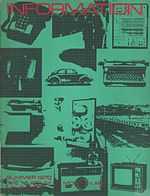Information art
Information art (also 'data art' or 'informatism' ) is an emerging field of electronic art that synthesizes computer science, information technology, and more classical forms of art, including performance art, visual art, new media art and conceptual art. [1] Information Art often includes interaction with computers that generate artistic content based on the processing of large amounts of data.[2]
Background

Informatism follows on the 1970 exhibition organized by Kynaston McShine called "Information", held at the Museum of Modern Art in New York City - a show that formally established conceptual art as a leading tendency in the United States. Conceptual art had emerged simultaneously in dozens of international locations around 1966. [3] At the same time arose the activities of Experiments in Art and Technology known as E.A.T. [4]
Artistic practice
Information art data can be manifested using photographs, census data, micropayments, personal profiles and expressions, video clips, search engine results, digital painting, network signals, and prose.[5]
References
- ↑ Edward A. Shanken has argued that little scholarship has explored the relationship between technology and conceptual art. He also claimed that there was an art-historical impetus to artificially distinguish information art from conceptual art. Edward A. Shanken, ‘Art in the Information Age: Technology and Conceptual Art,’ in Michael Corris (ed.), Conceptual Art: Theory, Myth and Practice (Cambridge: Cambridge University Press, 2004.
- ↑ See Charlie Gere Art, Time and Technology: Histories of the Disappearing Body (Berg, 2005). ISBN 978-1-84520-135-7 This text concerns artistic and theoretical responses to the increasing speed of technological development and operation, especially in terms of draws on the ideas of Jacques Derrida, Bernard Stiegler, Jean-François Lyotard and André Leroi-Gourhan, and looks at the work of Samuel Morse, Vincent van Gogh and Kasimir Malevich, among others.
- ↑ See Lucy R. Lippard, Six Years: the Dematerialization of the Art Object From 1966 to 1972 (1973. Berkeley: University of California Press, 1997).
- ↑ E.A.T. followed from the event Nine Evenings: Theatre and Engineering, organised by Robert Rauschenberg and Billy Klüver at the Armoury Building, New York City, 13–22 October, 1966 to promote the collaboration between artists and engineers. They also organised the Pepsi Pavilion at the World’s Fair, Osaka, in 1970. For a detailed discussion of the project see Bijvoet, Art as Inquiry, ch. 2.
- ↑ McKeough, Tim (February 29, 2008). "Frame That Spam! Data-Crunching Artists Transform the World of Information". Wired (CondéNet) (16.03). Retrieved 2008-03-05.
Further reading
- Alan Liu (2004). "The Laws of Cool: Knowledge Work and the Culture of Information", University of Chicago Press
- Kenneth R. Allan, "Understanding Information," in Michael Corris (ed.), Conceptual Art, Theory, Myth, and Practice (Cambridge: Cambridge University Press, 2004), 144-68.
- Roy Ascott (2003). Telematic Embrace. (Edward A. Shanken, ed.) Berkeley: University of California Press. ISBN 0-520-21803-5
- Barreto, Ricardo and Perissinotto, Paula “the_culture_of_immanence”, in Internet Art. Ricardo Barreto e Paula Perissinotto (orgs.). São Paulo, IMESP, 2002. ISBN 85-7060-038-0.
- Jack Burnham, (1970) Beyond Modern Sculpture: The Effects of Science and Technology on the Sculpture of this Century (New York: George Braziller Inc.
- Bullivant, Lucy (2007). 4dsocial: Interactive Design Environments (Architectural Design). London: John Wiley & Sons. ISBN 978-0-470-31911-6
- Bullivant, Lucy (2006). Responsive Environments: architecture, art and design (V&A Contemporary). London:Victoria and Albert Museum. ISBN 1-85177-481-5
- Bullivant, Lucy (2005). 4dspace: Interactive Architecture (Architectural Design). London: John Wiley & Sons. ISBN 0-470-09092-8
- Oliver Grau, Virtual Art, from Illusion to Immersion, MIT Press/Leonardo Books, 2004, pp. 237-240, ISBN 0-262-57223-0
- Paul, Christiane (2003). Digital Art (World of Art series). London: Thames & Hudson. ISBN 0-500-20367-9
- Peter Weibel and Shaw, Jeffrey, Future Cinema, MIT Press 2003, pp. 472,572-581, ISBN 0-262-69286-4
- Wilson, Steve Information Arts: Intersections of Art, Science and Technology Information Arts: Intersections of Art, Science, and Technology ISBN 0-262-23209-X
- Kynaston McShine, "INFORMATION", New York, Museum of Modern Art., 1970, First Edition. ISBN LC 71-100683
- Jack Burnham, ‘Systems Esthetics,’ Artforum (September, 1968); reprinted in Donna de Salvo (ed.), Open Systems: Rethinking Art C. 1970 (London: Tate Publishing, 2005)
- Edward A. Shanken, ‘Art in the Information Age: Technology and Conceptual Art,’ in Michael Corris (ed.), Conceptual Art: Theory, Myth and Practice (Cambridge: Cambridge University Press, 2004).
- Marga Bijvoet, (1997) Art as Inquiry: Toward New Collaborations Between Art & Science, Oxford: Peter Lang
- Frank Popper (1993) Art of the Electronic Age, Thames and Hudson Ltd., London, and Harry N. Abrams Inc, New York, ISBN 0-8109-1928-1
- Pavilion: Experiments in Art and Technology. Klüver, Billy, J. Martin, B. Rose (eds). New York: E. P. Dutton, 1972
- Dick Higgins, ‘Intermedia’ (1966), reprinted in Donna De Salvo (ed.), Open Systems Rethinking Art c. 1970 (London: Tate Publishing, 2005)
- Nicolas Bourriaud, Relational Aesthetics (Dijon: Les Presses du Réel, 2002, orig. 1997)
- Charlie Gere Digital Culture (Reaktion, 2002) ISBN 978-1-86189-143-3
See also
- Systems art
- Digital art
- Tradigital art
- Computer art
- Conceptual art
- Software art
- Systems thinking
- Algorithmic art
- Roy Ascott
- Knowledge visualization
- Experiments in Art and Technology
External links
- Intersections of Art, Technology, Science and Culture- Links
- The Danish Artnode Foundation-Links
- (FILE) Electronic Language International Festival.
- Leonardo/The International Society for the Arts, Sciences and Technology